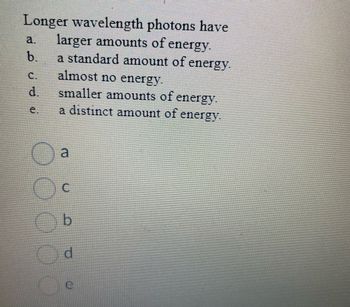
Chemistry
10th Edition
ISBN: 9781305957404
Author: Steven S. Zumdahl, Susan A. Zumdahl, Donald J. DeCoste
Publisher: Cengage Learning
expand_more
expand_more
format_list_bulleted
Concept explainers
Question

Transcribed Image Text:Longer wavelength photons have
a. larger amounts of energy.
b
a standard amount of energy.
almost no energy.
smaller amounts of energy.
a distinct amount of energy.
C
b
d
Expert Solution
This question has been solved!
Explore an expertly crafted, step-by-step solution for a thorough understanding of key concepts.
This is a popular solution
Trending nowThis is a popular solution!
Step by stepSolved in 4 steps with 2 images

Knowledge Booster
Learn more about
Need a deep-dive on the concept behind this application? Look no further. Learn more about this topic, chemistry and related others by exploring similar questions and additional content below.Similar questions
- 7-9 pleasearrow_forward11. Which of the following statements about light are true? a. Red Light has a shorter wavelength and higher energy than Blue Light. b. Red Light has a longer wavelength and lower energy than Blue Light. c. Red Light has a shorter wavelength and lower energy than Blue Light. d. Red Light has a longer wavelength and higher energy than Blue Light.arrow_forward5. Planck's equation relates the energy of a photon of light to its frequency. E= hv Where Planck's constant h =6.64 x 10-34 J.s And frequency (v) is measured in 1/seconds or hertz (Hz) If the frequency of a red spectral line is 1.60 x 1014 Hz, how much energy does one photon of this light have? a. b. If the frequency of a violet spectra line is at 2.50 x 1014 Hz, how much energy does one photon of this light have? 6. The visible light spectrum represents only a small portion of the electromagnetic spectrum. Infrared and ultraviolet radiations lie directly outside the visible range. * UV radiation is dangerous and is located just past the violet region on the spectrum. *IR radiation is harmless and is located just before the red region on the spectrum. Based on your calculations in question 5 above, explain why you think UV is more dangerous than IR.arrow_forward
- Which of the following is NOT a form ofpotential energy?1. a free electron moving at 1000 m/s2. gravity3. electrostatics (Coulomb’s Law)4. compression of a springarrow_forward5. For light with a wavelength of 6.245 x 10 m, determine the following: a. The frequency of this light The energy of a mole of photons of this light in kJ/m ol. C.arrow_forwardWhen a substance light, an electron undergoes a transition from the lowest-energy level to a higher-energy level.arrow_forward
- 26. Calculate the energy of a single photon of radiation that has a frequency of 1.00 x 1014 s. 34 (h = 6.63 x 10" J.s)arrow_forwardFor the photons with the following wavelengths, which of the photons possesses the least energy and which possesses the most energy? A. a photon of green light has a wavelength of 540 nanometers B. a photon of red light has a wavelength of 720 nanometers C. a photon of violet light has a wavelength of 400 nanometers D. a photon of infrared light has a wavelength of 1000 nanometers E. a photon of ultraviolet light has a wavelength of 300 nanometersarrow_forwardWhich wavelength of light has the highest frequency? a. 16 mm b. 4 nm c. 16 nm d. 4 mmarrow_forward
- Determine the energy of 1.30 mol of photons for each of the following kinds of light. (Assume three significant figures.) a. infrared radiation (1530 nm) b. visible light (490 nm) c. ultraviolet radiation (140 nm)arrow_forwardIn a photoelectric effect experiment, blue light shining on a metal surface caused photoelectrons to be emitted but red light did not. What explains this observation? A. Blue light has a higher intensity than red light B. Blue light has a larger wavelength than red light C. Blue light has a higher frequency than red light D. both A and B are true E. both B and C are truearrow_forwardCalculate the wavelength of yellow light in nanometers if the light has a frequency of 4.14 x 1014 s-1arrow_forward
arrow_back_ios
SEE MORE QUESTIONS
arrow_forward_ios
Recommended textbooks for you
 ChemistryChemistryISBN:9781305957404Author:Steven S. Zumdahl, Susan A. Zumdahl, Donald J. DeCostePublisher:Cengage Learning
ChemistryChemistryISBN:9781305957404Author:Steven S. Zumdahl, Susan A. Zumdahl, Donald J. DeCostePublisher:Cengage Learning ChemistryChemistryISBN:9781259911156Author:Raymond Chang Dr., Jason Overby ProfessorPublisher:McGraw-Hill Education
ChemistryChemistryISBN:9781259911156Author:Raymond Chang Dr., Jason Overby ProfessorPublisher:McGraw-Hill Education Principles of Instrumental AnalysisChemistryISBN:9781305577213Author:Douglas A. Skoog, F. James Holler, Stanley R. CrouchPublisher:Cengage Learning
Principles of Instrumental AnalysisChemistryISBN:9781305577213Author:Douglas A. Skoog, F. James Holler, Stanley R. CrouchPublisher:Cengage Learning Organic ChemistryChemistryISBN:9780078021558Author:Janice Gorzynski Smith Dr.Publisher:McGraw-Hill Education
Organic ChemistryChemistryISBN:9780078021558Author:Janice Gorzynski Smith Dr.Publisher:McGraw-Hill Education Chemistry: Principles and ReactionsChemistryISBN:9781305079373Author:William L. Masterton, Cecile N. HurleyPublisher:Cengage Learning
Chemistry: Principles and ReactionsChemistryISBN:9781305079373Author:William L. Masterton, Cecile N. HurleyPublisher:Cengage Learning Elementary Principles of Chemical Processes, Bind...ChemistryISBN:9781118431221Author:Richard M. Felder, Ronald W. Rousseau, Lisa G. BullardPublisher:WILEY
Elementary Principles of Chemical Processes, Bind...ChemistryISBN:9781118431221Author:Richard M. Felder, Ronald W. Rousseau, Lisa G. BullardPublisher:WILEY

Chemistry
Chemistry
ISBN:9781305957404
Author:Steven S. Zumdahl, Susan A. Zumdahl, Donald J. DeCoste
Publisher:Cengage Learning

Chemistry
Chemistry
ISBN:9781259911156
Author:Raymond Chang Dr., Jason Overby Professor
Publisher:McGraw-Hill Education

Principles of Instrumental Analysis
Chemistry
ISBN:9781305577213
Author:Douglas A. Skoog, F. James Holler, Stanley R. Crouch
Publisher:Cengage Learning

Organic Chemistry
Chemistry
ISBN:9780078021558
Author:Janice Gorzynski Smith Dr.
Publisher:McGraw-Hill Education

Chemistry: Principles and Reactions
Chemistry
ISBN:9781305079373
Author:William L. Masterton, Cecile N. Hurley
Publisher:Cengage Learning

Elementary Principles of Chemical Processes, Bind...
Chemistry
ISBN:9781118431221
Author:Richard M. Felder, Ronald W. Rousseau, Lisa G. Bullard
Publisher:WILEY